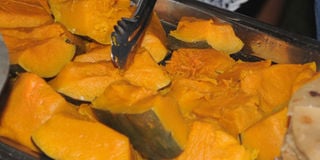Prime
The rich golden creamy vegetable

Pumpkins are a delicacy in Uganda and the World over. PHOTO BY FAISWAL KASIRYE
What you need to know:
PUMPKIN.The vegetable which can easily be mistaken for a fruit can be eaten in as many ways as it can be prepared. One thing remains the same though,its rich creamy taste.
Every fortnight, Dr Ken Bagonza’s dinner table must have a certain vegetable. The medical practitioner who is based at Nakasero Hospital says he cannot do without pumpkins because the vegetable comprises various nutrients and minerals ranging from copper, potassium to phosphorus which are good for the building of different body cells. A member of the plant family cucurbits, pumpkins have a close relationship with melons and cucumbers.
Kalya, the Head Chef at Melting Pot Restaurant along Buganda Road, says pumpkin can be prepared in various ways. In western Uganda, especially among the Banyankole and Bakiga, pumpkins are cooked with beans.
“Simply boil the beans, preferably in a pot, and then when they are half cooked, add the pumpkin pieces after removing the hard cover. One should then leave both to boil after putting a bit of salt. When ready, one can either eat it in that very form or mash it,” Kalya says.
In Buganda, the chef states, steaming under banana leaves, is the most common method of preparation especially over other foods such as luwombo.
“There is a spicy aroma that comes from the banana leaves and most Baganda want it absorbed in the pumpkin,” he adds.
In the north and east, a big percentage of people prefer to basically cut the pumpkin into pieces and dry them under the sun for a few hours and then bring to boil after adding a bit of salt as Grace Apio, an Itesot shares. It is then eaten directly when ready.
The different faces of pumpkin
There are individuals who go right ahead to roast, make pies or cakes and even soup out of it especially in the Western society. For the pumpkin soup, water is boiled, then spices are added such as onions, curry powder and salt. The pumpkins are then added onto the content. When ready after about one hour, the stock is drained away from the pumpkin. It is later mashed and either milk or butter is added to taste. For the cakes and pies, the pumpkin is boiled and then the orange part is smashed and added with the rest of the ingredients.
Surprisingly, Kalya points out that there is also another class of individuals that actually loves eating the pumpkins when they are still small and tender. The small pumpkins are picked from the vines when they are still small. Afterwards, they are crushed into powder form and then added into any preferred sauce with the common one being groundnut paste.
Much as some individuals throw away the seeds, Dr Bagonza advises that they should actually be eaten since they are a good source of dietary fibre and mono-unsaturated fatty acids which are good for the heart. Therefore, with the available options, you can prepare your pumpkin using a method of your preferred choice.
==========================
The local names
•Luganda- Nsujju
•Lukiga/Lunyakole- Ekyozi
•Langi & Acholi - Okono
•Lusoga- Eilibwa
•Lugisu- Liwondo
•Ateso- Esujjo
•Lutooro- Omwongo




